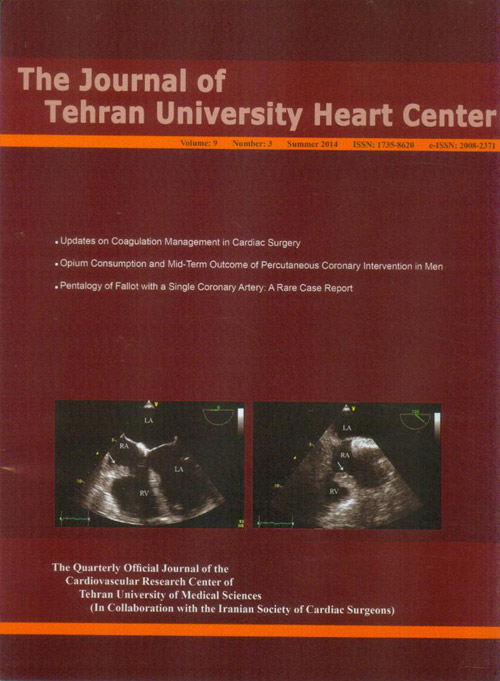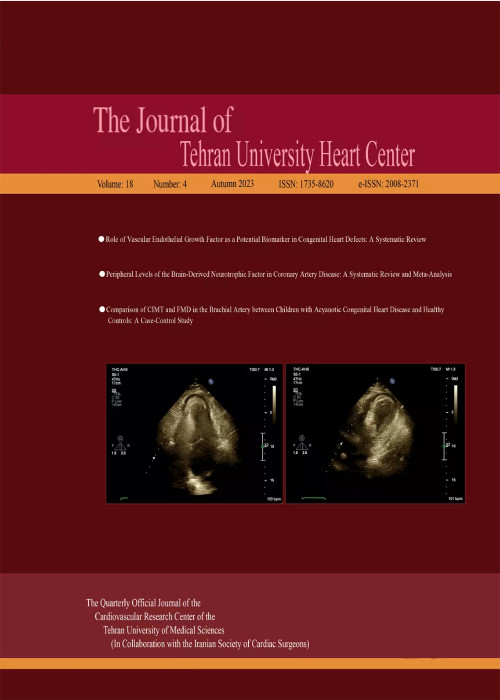فهرست مطالب

The Journal of Tehran University Heart Center
Volume:9 Issue: 3, Jul 2014
- تاریخ انتشار: 1393/06/03
- تعداد عناوین: 12
-
-
Page 104BackgroundThe use of thrombolytic agents in the treatment of hemodynamically stable patients with acute submassive pulmonary embolism (PTE) remains controversial. We, therefore, conducted this study to compare the effect of thrombolytic plus anticoagulation versus anticoagulation alone on early death and adverse outcome following submassive PTE.MethodsWe conducted a study of patients with acute pulmonary embolism and pulmonary hypertension or right ventricular dilatation/dysfunction but without arterial hypotension or shock. The patients were randomly assigned in a single-blind fashion to receive an anticoagulant [Enoxaparin (1 mg/kg twice a day)] plus a thrombolytic [Alteplase(100 mg) or Streptokinase (1500000 u/2 hours)] or an anticoagulant [Enoxaparin (1 mg/kg twice a day)] alone. The primary endpoint was in-hospital death or clinical deterioration requiring an escalation of treatment. The secondary endpoints of the study were major bleeding, pulmonary hypertension, right ventricular dilatation at the end of the first week, and exertional dyspnea at the end of the first month.ResultsOf 50 patients enrolled, 25 patients were randomly assigned to receive an anticoagulant plus a thrombolytic and the other 25 patients were given an anticoagulant alone. The incidence of the primary endpoints was significantly higher in the anticoagulant-alone group than in the thrombolytic-plus-anticoagulant group (p value = 0.022). At the time of discharge, pulmonary artery pressure was significantly higher in the anticoagulant-alone group than in the thrombolytic-plus-anticoagulant group (p value = 0.018); however, reduction in the right ventricular size or normalization of the right ventricle showed non-significant differences between the two groups. There was no significant difference regarding the New York Heat Association (NYHA) functional class between the two groups at the end of the first month (p value = 0.213). No fatal bleeding or cerebral bleeding occurred in the patients receiving an anticoagulant plus a thrombolytic.ConclusionWhen given in conjunction with anticoagulants, thrombolytics may improve the clinical course of stable patients who have acute submassive pulmonary embolism and prevent clinical deterioration.
-
Page 109BackgroundPercutaneous balloon mitral valvotomy (BMV) is the gold standard treatment for rheumatic mitral stenosis (MS) in that it causes significant changes in mitral valve area (MVA) and improves leaflet mobility. Development of or increase in mitral regurgitation (MR) is common after BMV. This study evaluated MR severity and its changes after BMV in Iranian patients.MethodsWe prospectively evaluated consecutive patients with severe rheumatic MS undergoing BMV using the Inoue balloon technique between February 2010 and January 2013 in Madani Heart Center, Tabriz, Iran. New York Heart Association (NYHA) functional class and echocardiographic and catheterization data, including MVA, mitral valve mean and peak gradient (MVPG and MVMG), left atrial (LA) pressure, pulmonary artery systolic pressure (PAPs), and MR severity before and after BMV, were evaluated.ResultsTotally, 105patients (80% female) at a mean age of 45.81 ± 13.37 years were enrolled. NYHA class was significantly improved after BMV: 55.2% of the patients were in NYHA functional class III before BMV compared to 36.2% after the procedure (p value < 0.001). MVA significantly increased (mean area = 0.64 ± 0.29 cm2 before BMV vs. 1.90 ± 0.22 cm2 after BMV; p value < 0.001) and PAPs, LA pressure, MVPG, and MVMG significantly decreased. MR severity did not change in 82 (78.1%) patients, but it increased in 18 (17.1%) and decreased in 5 (4.8%) patients. Patients with increased MR had a significantly higher calcificationscore (2.03 ± 0.53 vs.1.50 ± 0.51; p value < 0.001) and lower MVA before BMV (0.81 ± 0.23 vs.0.94 ± 0.18; pvalue = 0.010). There were no major complications.ConclusionInour study, BMV had excellent immediate hemodynamic and clinical results inasmuch as MR severity increased only in some patients and, interestingly, decreased in a few. Our results, underscore BMV efficacy in severe MS. The echocardiographic calcification score was useful foridentifying patients likely to have MR development or MR increase after BMV.
-
Page 115BackgroundControversy persists over thepotential benefits/harms of opium consumption in coronary heart disease. This study investigated the association between 12 months'' major adverse cardiac events (MACE) and pre-procedural opium consumption among patients undergoing percutaneous coronary intervention (PCI).MethodsRetrospectively, 1545 consecutive men who underwent PCI between 21st June 2009 and 20th June 2010 at Tehran Heart Center and were registered in the PCI Databank were entered into this cohort study. The occurrence of MACE, defined as cardiac death, non-fatal myocardial infarction, and need for target vessel revascularization (TVR) or target lesion revascularization (TLR), was compared between two groups of opium consumers and non-consumers in 350 (22.7%) patients.ResultsSixty-four (0.86%) patients expired within 12 months. After adjustment for potential confounders, analysis revealed that opium consumption had no significant relationship with 12 months'' MACE [11(3.1%) vs. 53(4.4%); p value = 0.286, among opium users vs. non users, respectively].Furthermore, the different components of MACE, including target vessel revascularization, target lesion revascularization, coronary artery bypass graft, and non-fatal myocardial infarction, were not significantly related to opium use.ConclusionPre-procedural opium usage in patients undergoing PCI was not associated with 12 months'' MACE.
-
Page 120Background
Surgical site infection is known as a common complication after cardiac surgery, and Cefazolin is the best prophylactic antibiotic to prevent this complication. The goal of this study was to evaluate the effect of continuous and intermittent Cefazolin for the prevention of superficial surgical site infection following off-pump coronary artery bypass (OPCAB).
MethodsThis prospective randomized clinical trial study was conducted on 141 patients candidated for OPCAB and divided into two groups. This study was performed between February 2011 and February 2012 in the Iranian city of Yazd. Patients in both groups received 2 g of Cefazolin as a starting dose and at 30 minutes before incision. Definition of surgical site infections was according to the Centers for Disease Control and Prevention Criteria (CDC-criteria). In the continuous infusion group (n = 74), 3 g of Cefazolin was infused over a 24-hour period after surgery. In the intermittent group (n = 67), 1 g of Cefazolin was administered at 3, 11, and 19 hours after the starting dose. Hyperlipidemia, diabetes, hypertension, smoking, history of heart disease, and incidences of superficial infection were compared between the two groups. Duration of follow- up was 4 weeks.
ResultsThe mean age of the patients was 60.49 ± 10.63 years. The patients were 30.5% female and 69.5% male. There were no significant differences in age, body surface area, duration of operation, number of distal grafts, number of proximal grafts, and duration of hospital stay before heart surgery between two groups. The incidence of infection in intermittent group was (7.5%) and in continuous groups was (2.7%). There was no significant difference in the incidence of infection between the two groups (p value = 0.26).
ConclusionOur findings in this study showed no significant differences between continuous and intermittent Cefazolin for the prevention of superficial surgical site infections after OPCAB.
-
Association between Sexual Function and Marital Relationship in Patients with Ischemic Heart DiseasePage 124BackgroundPatients with ischemic heart disease (IHD) may report difficulties with sexual function and marital relationship. However, there is a dearth of studies focusing on the association between these aspects in IHD patients. The present study sought to assess the association between sexual function and marital relationship among IHD patients and also test the effect modification of gender, education level, and marital distress on the above association.MethodsIn this cross-sectional study, 551 patients with IHD were enrolled and their sexual function and marital relationship quality were assessed with the Relation and Sexuality Scale (RSS) and Revised Dyadic Adjustment Scale (RDAS), respectively. Association between marital relationship quality and sexual function was assessed with respect to gender, education level, and marital distress.ResultsMost participants (72%) were men at a mean age of 57 ± 11 (range = 36-80) years. Total sexual function was significantly correlated with total marital quality (r = -0.28), marital consensus (r = -0.17), marital coherence (r = -0.19), marital affection expression (r = -0.22), and marital satisfaction (r = -0.25). Total marital quality also showed a significant association with sexual fear (r = -0.11). These associations were moderated by gender, education level, and marital distress level.ConclusionAmong the IHD patients, sexual function and marital relationship quality showed a mild to moderate association. Association between sexual function and marital relationship quality, however, may depend on gender, education level, and marital distress level.
-
Page 132Anomalies of origin, course, and distribution of coronary arteries, including single coronary artery, are well known in patients with Tetralogy of Fallot. However, to the best of our knowledge, there is no published case report of Pentalogy of Fallot with a single coronary artery. Herein, we introducea 22-year-old female patient diagnosed via echocardiography and cardiac catheterization preoperatively as Pentalogy of Fallot with a single coronary artery arising from the left coronary sinus.
-
Page 135Coronary artery anomalies are rare, with their incidence varying from 1 to 5%. Angiography is a commonly used modality for the assessment of coronary artery anomalies. Based on previous reports, a majority of coronary artery anomalies are of origin or distribution, with separate ostia of the left anterior descending artery and left circumflex artery. Coronary artery anomalies may cause myocardial ischemia secondary to atherosclerosis in the same artery. We present a rare case of duplicated right coronary artery with a separate ostium, which caused myocardial ischemia. Our patient was a 51-year-old diabetic woman with typical chest pain and dyspnea on exertion. Electrocardiography showed left axis deviation, poor R progression, and biphasic T wave in the precordial leads. Echocardiography revealed left ventricular ejection fraction of 30-35% and global hypokinesia. Coronary angiography demonstrated three-vessel disease and a double ostial right coronary artery. We recommended coronary artery bypass graft surgery, but the patient refused it and we continued her treatment with anti-ischemic drugs.
-
Page 137Atrioventricular groove rupture is a rare, albeit mortal, complication following mitral valve surgery. Avoidance is the best strategy but it cannot fully prevent the occurrence of this complication. Several repair techniques have been described with varying success rates; however, the rarity of the complication precludes consensus about the safest technique. Here we report two cases of posterior atrioventricular groove rupture. Both cases were diagnosed immediately after the cessation of cardiopulmonary bypass. Repair was performed successfully with a technique involving the use of biological glue. The postoperative course was uneventful for both of them. Both cases are well with normally functioning mitral prostheses; one with a follow-up time of 5.5 years and the other 10 months. We believe that the glue provides additional hemostasis and support to the repaired area.
-
Page 140Thrombotic thrombocytopenic purpura (TTP) is a rare syndrome affecting multiple organs. There is no sufficient evidence regarding the clinical cardiac manifestations of TTP. Nonetheless, pathologic cardiac involvement is quite frequent in acute TTP, which is predominantly manifested as myocardial necrosis due to coronary arteriolar microthrombosis. The present case report describes a 43-year-old man with long-standing remitted TTP, who suffered from a sequence of refractory thrombotic epicardial coronary events. Aggressive medical and interventional therapies, including long-term dual antiplatelets and coronary angioplasty, were finally successful in remitting the thrombotic events. During his two-year follow up, he has been asymptomatic.


